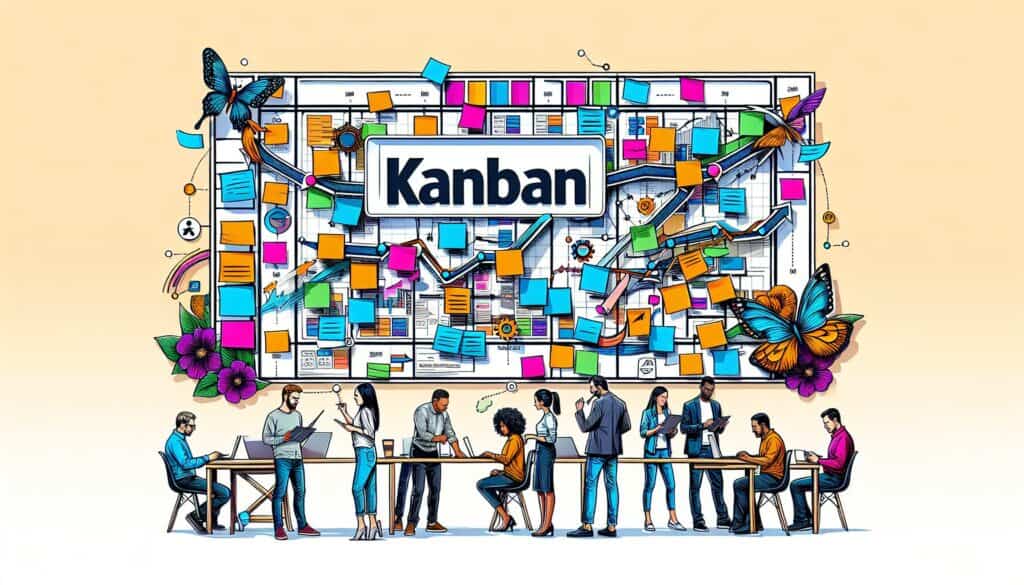Méthode de gestion visuelle du flux de travail conçue pour aider les équipes à visualiser leur travail, à limiter les travaux en cours (WIP) et à maximiser l'efficacité (ou le flux).
- Méthodologies : Clients et marketing, Économie
Kanban

Kanban
- Méthodologie Agile, Amélioration continue, Kanban, Production allégée, Amélioration des processus, Gestion de projet, Travail d'équipe, Cartographie de la chaîne de valeur
Objectif :
Comment il est utilisé :
- Les éléments de travail sont représentés par des cartes sur un Kanban qui est divisé en colonnes représentant les étapes du flux de travail. Les équipes font passer le travail d'une étape à l'autre en fonction de la capacité, avec des limites explicites d'encours pour chaque étape afin d'éviter les goulets d'étranglement.
Avantages
- Améliore la visibilité et la transparence du flux de travail ; aide à identifier rapidement les goulets d'étranglement ; flexible et adaptable à différents processus ; favorise le flux continu et réduit les délais de livraison en limitant les stocks en attente.
Inconvénients
- Ne fournit pas intrinsèquement d'estimations de temps pour les tâches ; Peut être moins efficace si les limites de l'encours ne sont pas respectées ou si les tâches ne sont pas décomposées de manière appropriée ; Nécessite une discipline d'équipe et un engagement envers le système.
Catégories :
- Idéation, Lean Sigma, Fabrication, Conception de Produits, Gestion de projet
Idéal pour :
- Gestion et amélioration des flux de travail, en particulier pour les équipes ayant un flux continu de tâches ou dans des environnements opérationnels.
La méthodologie Kanban est utilisée efficacement dans un large éventail de secteurs tels que le développement de logiciels, la fabrication, les soins de santé et la logistique, où il est impératif de gérer des flux de travail continus. Par exemple, dans les équipes de développement de logiciels, les tableaux Kanban permettent de visualiser les fonctionnalités en cours de développement, de test et de déploiement, ce qui permet des ajustements en temps réel en fonction de la charge de travail et des priorités de l'équipe. Dans les environnements opérationnels, tels que les usines, Kanban peut faciliter la gestion des stocks, en veillant à ce que les fournitures soient acheminées sans heurts dans les chaînes de production en alignant l'offre sur la demande. Cette méthodologie peut être mise en œuvre au cours des différentes phases d'un projet, de la conception initiale à la maintenance continue, et est bénéfique pour les équipes interfonctionnelles, notamment les concepteurs, les ingénieurs et les chefs de produit, qui ont besoin de collaborer efficacement. Le lancement d'un système Kanban implique souvent des chefs d'équipe ou des gestionnaires de projet qui établissent le cadre, tandis que tous les membres de l'équipe participent à la mise à jour et à la gestion du tableau, en veillant à ce que le travail reste visible et à ce que les responsabilités soient partagées. Avec des limites définies pour le travail en cours, l'approche Kanban encourage les équipes à se concentrer sur l'achèvement des tâches avant d'en entreprendre de nouvelles, ce qui atténue le risque de surcharge et permet de se concentrer sur l'obtention de résultats de qualité. Des examens réguliers permettent d'identifier les goulets d'étranglement et d'intervenir en temps utile pour améliorer les processus, ce qui fait de Kanban un outil polyvalent pour améliorer la productivité des équipes et l'efficacité opérationnelle.
Principales étapes de cette méthodologie
- Visualisez le flux de travail en créant un tableau Kanban avec des colonnes pour chaque étape du processus.
- Définir des types d'éléments de travail et assigner des tâches aux cartes qui représentent ces éléments.
- Définissez des limites explicites de travail en cours (WIP) pour chaque colonne afin de contrôler le flux et d'éviter les goulets d'étranglement.
- Mettez en place un système de tirage au sort dans lequel les membres de l'équipe tirent des tâches de la colonne précédente lorsque la capacité le permet.
- Contrôler et gérer les flux en ajustant les limites des encours et en apportant des améliorations aux processus sur la base des performances observées.
- Procéder à des évaluations régulières et à des réunions de synthèse pour discuter des progrès, des défis et des ajustements potentiels.
- Créer des boucles de retour d'information pour permettre une amélioration continue, en adaptant le conseil et les flux de travail si nécessaire.
Conseils de pro
- Effectuer régulièrement des examens rétrospectifs pour affiner les limites de l'encours et s'assurer qu'elles reflètent la capacité réelle de l'équipe et l'efficacité du flux de travail.
- Utiliser des mesures telles que le temps de cycle et le délai d'exécution pour apporter au tableau Kanban des ajustements fondés sur des données et améliorer le rendement.
- Mettez en place des "plans de nage" sur le tableau Kanban pour classer les éléments de travail par type, priorité ou rôle de l'équipe, afin d'améliorer la visibilité et de se concentrer sur les tâches essentielles.
Lire et comparer plusieurs méthodologies, nous recommandons le
> Référentiel méthodologique étendu <
ainsi que plus de 400 autres méthodologies.
Vos commentaires sur cette méthodologie ou des informations supplémentaires sont les bienvenus sur le site web de la Commission européenne. section des commentaires ci-dessous ↓ , ainsi que toute idée ou lien en rapport avec l'ingénierie.
Contexte historique
1930
1940
1950
1950
1958
1960
1960
1930
1940
1949
1950
1950
1960
1960
1960
(si la date est inconnue ou n'est pas pertinente, par exemple "mécanique des fluides", une estimation arrondie de son émergence notable est fournie)















Articles Similaires
Simulation de Monte Carlo
Tests basés sur des modèles
Contrôle des modèles
Recherche sur les méthodes mixtes
À l'épreuve des erreurs (Poka-Yoke)
Test du profil de la mission